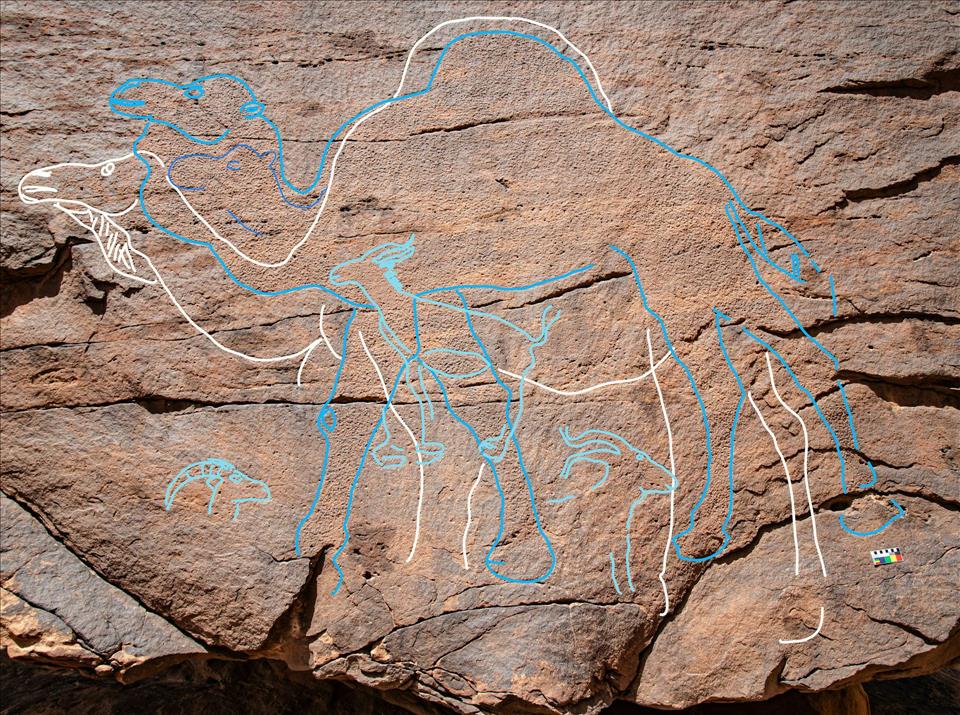
12,000-Year-Old Rock Art Marked Ancient Water Sources In Arabia's Desert
Standing on a narrow ledge and with primitive tools, they engraved into the rock an image of a life-sized camel. This wasn't the first artwork of its kind: in fact, there was already an entire row of fresh camel engravings on the 39-metre-high cliff face, below which a shallow lake sparkled in the sunshine.
Over thousands of years, these engravings weathered the elements. They gradually eroded until they were almost invisible and had been forgotten.
That is, until our international team discovered them and more than 170 others while on a field trip to the region, which sits near the southern edge of the Nefud Desert in Saudi Arabia, roughly two years ago.
As we explain in a new study , published today in Nature Communications, the engravings would have marked important desert water sources – and demonstrate the resilience and innovation of people who lived in such a harsh, arid environment.
The engravings are near the southern edge of the Nefud Desert in Saudi Arabia. Sahout Rock Art and Archaeology Project Searching for clues
Our earlier research had shown that between 10,000 and 6,000 years ago Arabia was much wetter than it is today.
Grasslands had spread into areas that are now desert, and cattle herders used these pastures for their herds.
The rock art they left behind is well known from two UNESCO World Heritage sites.
We could see there was also older rock art at these UNESCO sites. It was much larger and more detailed, showing life-sized and naturalistic camels and wild donkeys. But it was not clear how old it was. So in May 2023 we set out to find more of this ancient rock art in the hope of finding clues about its age.
The newly discovered engravings include 130 images of large, life-sized animals – camels, ibex, wild donkeys, gazelles and aurochs. Sahout Rock Art and Archaeology Project Life-sized engravings
In total, we identified more than 60 rock art panels containing 176 engravings in three previously unexplored areas – Jebel Arnaan, Jebel Mleiha and Jebel Misma. The engravings include 130 images of large, life-sized animals – camels, ibex, wild donkeys, gazelles and aurochs. Some are almost three metres long and more than two metres high.
We reached the first panel via a long off-road track which cut through a beautiful mountain landscape. A cool breeze made the heat of the emerging Saudi summer bearable.
The rock art panel showed two large camels, one on top of the other. The older camel looked as though it was in motion and about to stand up, the other like it was striding across the rock surface.
We were excited to find undisturbed archaeological layers directly beneath the engraved camels. In one sealed layer we even found an engraving tool that was once used to make rock art.
Luminescence dating – a dating method that measures when sediment was last exposed to sunlight – revealed the layer in which the tool was found is about 12,000 years old.
The same layer also contained artefacts that are typical for this time, including small arrowheads, stone beads and even a bead made from a seashell.
An arrowhead uncovered during excavations. Michael Petraglia A far-reaching network
These artefacts tell us the people who made the rock art were part of a far-reaching network. They used the same stone tools and jewellery as communities in the Levant, 400 kilometres further north.
Significantly, our team also discovered the rock art was placed near ancient seasonal lakes.
At the end of the last ice age, during the Last Glacial Maximum, the climate was extremely dry.
These lakes, dated at roughly 15,000 years, are the first evidence of surface water returning to Arabia following the extremely arid period. And they move the timeline of the returning humid conditions back thousands of years, enlarging the opportunity window for humans to settle in these dry inland conditions.
Our results show 12,000 years ago, humans were able to use these seasonal lakes to survive in the desert. They marked these water sources, and the paths leading to them, with monumental rock art.
We don't know why they did this. But even for us today, the camel is a striking symbol for survival in the desert.

Legal Disclaimer:
MENAFN provides the
information “as is” without warranty of any kind. We do not accept
any responsibility or liability for the accuracy, content, images,
videos, licenses, completeness, legality, or reliability of the information
contained in this article. If you have any complaints or copyright
issues related to this article, kindly contact the provider above.


















Comments
No comment